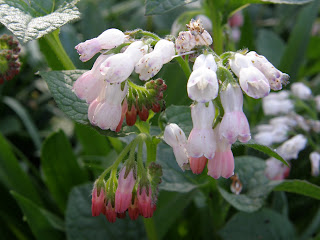
I'm finally back to do the second post about my day in Oxford. The last ten days or so has been rather hectic, my husband has finally had his surgery and we are told that it has been successful which is a relief. We also are celebrating the arrival of another little grandson who was born in the early hours of Saturday morning. Gabriel now has a little brother called Elisha George and I shall be going down to Suffolk to see them on Thursday. I'm staying a few days so that I can do some exploring, I love Suffolk and it is full of beautiful villages and quiet country lanes. However back to Oxford - the view above is taken through the entrance gates of Corpus Christi College, it shows the stone flagged Front Quad and the tall column is a sundial.

I wish I could have got closer to photograph this amazing sundial properly but the College was closed. It dates back to 1581 and the main column has the principal south facing sundial on it (not visible in this photo) and a perpetual calendar which shows the University terms. The pelican on the top, which is pecking blood from its breast to feed its young, represents 'Corpus Christi' (the Body of Christ). Apart from the main sundial on the column there are at least eight more, four below the coats of arms and then four more on the next level up. Click to enlarge the photo and you will see it better.

This wonderful carved stone panel was crafted around 1420 and stands over the gatehouse of Merton College. The images depict St John the Baptist in the wilderness with various animals including a lovely unicorn. I was able to go in and look round here, Merton was founded in 1264 and claims to be the oldest college in Oxford. J.R.Tolkien was Professor of English here between 1945 and 1959 when he was writing his 'Lord of the Rings' trilogy.

Front Quad with the old Warden's Lodgings on the far left.

Mob Quad is the earliest quadrangle in Oxford and it houses the library of Merton College which dates from 1373 and is the oldest continuously used library for academics in the world.

The archway that leads into Fellows Quad has the twelve signs of the zodiac carved into the roof bosses. It was built by Warden Fitzjames as part of his new lodgings in 1497 and he actually had a horoscope cast for his new house.

A close-up of my particular sign - Virgo.

This is probably my favourite of the Colleges I visited - these are the gardens of New College which are enclosed by the old city walls of Oxford.

One of the bastions which allows a better defensive position than a straight wall does. Oxford was the headquarters of Charles I during the English Civil War and it was along these walls that the Royalists made their final stand before the city surrendered to the Roundheads in June 1646. Hiss, boo at this point - I have always been a staunch Royalist!

The cloisters of New College which are beautifully quiet and peaceful and they enclose a small garden.

Looking into the garden through one of the cloister windows.

The name New College is rather misleading, it is actually one of the oldest colleges in Oxford being founded in 1379 by William Wykeham, Bishop of Winchester.
This stone staircase leads up into the dining hall where there is a portrait of William Wykeham and also of Canon William Spooner who was given to transposing the beginnings of words and whose name gave rise to 'spoonerisms'. Among them is one that really makes me laugh - 'The Lord is a shoving leopard'. I'm sure you can all work out what he actually intended to say!

On New College Lane stands this white house where the astronomer Edmund Halley lived and had his observatory. He discovered that comets move in an orbit round the sun and Halley's Comet was named after him.

The plaque on the wall of the house. You will need to cick on it to read what it says.

The Sheldonian Theatre was one of the earliest architectural designs by Sir Christopher Wren who is most famous for his design for St Paul's Cathedral in London.
When he designed the Sheldonian he was a Professor of Astronomy at New College, Oxford and still plain Christopher Wren - the knighthood came later.

Radcliffe Camera was originally built in the mid 18th century to house the Radcliffe Science Library, it is now a part of the famous Bodleian Library and is used as a reading room for students. There was so much more to see in Oxford and I shall definitely go again to see all that I didn't have time for on this visit.

Finally the lovely old 16th century farmhouse where I stayed for the two nights I was in Oxfordshire.

























